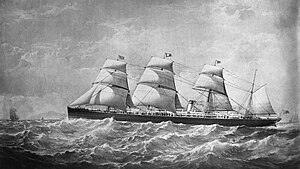RMS Atlantic

RMS Atlantic
|
|
| History | |
|---|---|
| Name: | Atlantic |
| Namesake: | Atlantic ocean |
| Owner: | White Star Line |
| Operator: |  |
| Builder: |
|
| Yard number: | 74 |
| Laid down: | 1870 |
| Completed: | 3 June 1871 |
| Maiden voyage: | 8 June 1871 |
| Fate: | Ran onto rocks and sank off the coast of Nova Scotia, 1 April 1873 |
| General characteristics | |
| Type: | Ocean liner |
| Tonnage: | 3,707 tons |
| Length: | 128.4 m (421.3 ft) |
| Beam: | 12.4 m (40.7 ft) |
| Draught: | 11 ft (3.4 m) |
| Installed power: | Steam engine producing 600 hp (450 kW) |
| Propulsion: | Single propeller, sail |
| Sail plan: | Four masts |
| Speed: | 14.5 knots (26.9 km/h) |
| Complement: | 1,166 passengers |
RMS Atlantic was a transatlantic ocean liner of the White Star Line that operated between Liverpool, United Kingdom, and New York City, United States. During the ship's 19th voyage, on 1 April 1873, it ran onto rocks and sank off the coast of Nova Scotia, killing at least 535 people. It remained the deadliest civilian maritime disaster in the Northern Atlantic until the sinking of SS La Bourgogne on 2 July 1898 and the greatest disaster for the White Star Line prior to the loss of Titanic 39 years later.
Atlantic was built by Harland and Wolff in Belfast in 1870, and was the second ship built for the newly born White Star Line. She was powered by a steam engine producing 600 horsepower (450 kW) driving a single propeller, along with four masts rigged for sail. She sailed for New York on her maiden voyage on 8 June 1871.
On 20 March 1873 Atlantic departed on her 19th voyage from Liverpool with 952 people on board, of whom 835 were passengers. En route, the captain decided to make port at Halifax, Nova Scotia to replenish coal for the boilers.
During the approach to Halifax on the evening of 31 March, the captain and 3rd officer were on the bridge until midnight, while Atlantic made her way through a storm, proceeding at 12 knots (22 km/h) for the entrance of Halifax harbour, experiencing intermittent visibility and heavy seas. Unbeknownst to the crew or passengers, Atlantic was approximately 12 1⁄2 miles (20.1 km) off-course to the west of Halifax Harbour. Officers failed to take soundings, post a masthead lookout, reduce speed or wake the captain as they approached the unfamiliar coast. They somehow did not spot the Sambro Lighthouse, the large landfall lighthouse which warns mariners of the rocky shoals to the west of the harbour entrance.
...
Wikipedia
